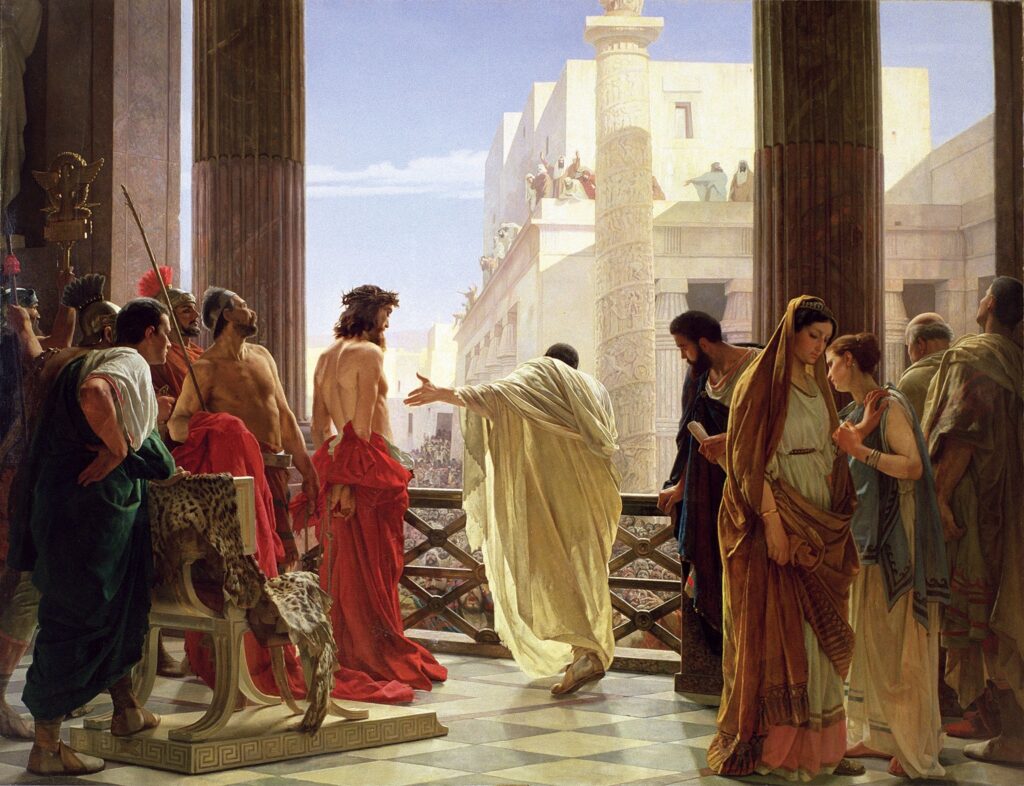* * * *

* * * *
Friday, February 2, 2024 was the Feast of the Presentation of Jesus at the Temple. It recalls Mary and Joseph presenting Jesus, as a baby, 40 days after His birth. (The birthday we celebrate as Christmas.) In doing so His parents followed a thousand-year-old custom that began with Moses. In Exodus 13:2, God told Moses, “Consecrate to me every firstborn male:”
Counting forward from December 25 as Day One [for Jesus], we find that Day Forty is February 2. A Jewish woman is in semi-seclusion for 40 days after giving birth to a son, and accordingly it is on February 2 that we celebrate the coming of Mary and Joseph with the infant Jesus to the Temple at Jerusalem.
Then there’s the painting above, of Jesus “presented” a second time. But this time it was Pontius Pilate, showing Him to the mob. A reminder that from the time of His first Presentation – at just over a month old – Jesus’ life was one long journey to that second presentation. (On the eve of making the sacrifice that would literally change history, if not “split history in two.”)
In a similar way, February 2, 2024 marks the beginning of our own spiritual journey: “Today is the first day of the rest of your life.” And this year – as every church year – that journey goes through the rest of Epiphany Season, then to Mardi Gras, followed by Lent, then on into Easter Week. (A reminder that life is not all fun and games. It’s an alternating rhythm of good times and “challenges.” Put another way, an alternating rhythm of “feasting and fasting.”)
Getting back to the Presentation, it’s one of the most ancient Church feasts, dating back as far as the fourth century in Jerusalem. As to the original Presentation, where it all started:
Luke explicitly says that Joseph and Mary take the option provided for poor people (those who could not afford a lamb; Leviticus 12:8), sacrificing “a pair of turtledoves, or two young pigeons.” Leviticus 12:1–4… Upon bringing Jesus into the temple, they encountered Simeon[, who] had been promised that “he should not see death before he had seen the Lord’s Christ” (Luke 2:26). Simeon then uttered the prayer that would become known as the Nunc Dimittis, or Canticle of Simeon, which prophesied the redemption of the world by Jesus
But were Mary and Joseph really poor? Some might ask, “What happened to that gold, frankincense and myrrh that the Three Wise Men gave the parents?” (The gold could be easily spent, while the other two would be easily “hockable.”) A medieval Jesuit had this comment: “Although the three kings had offered to Christ a great quantity of gold, still the Blessed Virgin, zealously affected towards poverty, accepted but little of it, that she might show her contempt of all earthly things.” Which is as good an answer as any, but still, “Where whence those gifts?”
But that’s what people call a rabbit trail. A “convoluted discourse or tangential aside.” More to the point, could there be a deeper meaning of the Presentation in the Temple? According to the St. Paul Center for Biblical Theology, the answer is Yes.
Aside from Mary having to be purified, all male firstborns had to be “consecrated to God in a special way.” But there were two other elements to the story. First, the parents didn’t have to go to the Temple, so Mary and Joseph were being “extra devout by going to the Temple for this special day.” (And according to Google Maps, that’s at least a 33-hour hike of over 90 miles.)
Second, according to one Pope, Luke was saying that instead of being “redeemed” and restored to his parents, Jesus was personally handed over, “given over completely to God.” Thus:
The Presentation isn’t just another boring religious ritual. On the contrary, it is a deeply symbolic moment pointing to Jesus’s divine identity, and to Mary and Joseph’s perfect cooperation with His divine mission.
And speaking of handing over a life to God, the Daily Office for February 3, 2024, added another set of saints to remember, The Dorchester Chaplains. They were four chaplains who died rescuing other passengers when a German submarine torpedoed the American troop ship Dorchester on February 3, 1943. (In what was called “the second-worst sea disaster of World War II.”)
The chaplains helped the other soldiers board lifeboats and gave up their own life jackets when the supply ran out. The chaplains joined arms, said prayers, and sang hymns as they went down with the ship.
All lieutenants, the group included “Methodist minister the Reverend George L. Fox, Reform Rabbi Alexander D. Goode (PhD), Catholic priest Father John P. Washington, and Reformed Church in America minister the Reverend Clark V. Poling.”
Wikipedia added more detail, the gist of which is that panic set in when a torpedo knocked out the ship’s electrical system, at 1:00 in the morning in the stormy North Atlantic. The chaplains did what they could to calm passengers and organize the evacuation. They got life jackets, but when the preservers ran out the chaplains gave theirs to others. Then too, the jackets did little to protect against hypothermia in the frigid water; “hundreds of dead bodies were seen floating on the water, kept up by their life jackets.” Thus only 230 of the 940 passengers survived.
As I swam away from the ship, I looked back. The flares had lighted everything. The bow came up high and she slid under. The last thing I saw, the Four Chaplains were up there praying for the safety of the men. They had done everything they could. I did not see them again. They themselves did not have a chance without their life jackets.
That’s according to one survivor. Others heard different languages in the chaplains’ prayers, “including Jewish prayers in Hebrew and Catholic prayers in Latin” as the ship sank. A reminder again “that life is not all fun and games,” and that we have been gifted. Despite all the troubles we see in the news, we are blessed to be alive and enjoy the upcoming church seasons.
* * * *

* * * *
The upper image is courtesy of Pontius Pilate – Wikipedia. The caption: “Ecce Homo (‘Behold the Man’), Antonio Ciseri‘s depiction of Pilate presenting a scourged Jesus to the people of Jerusalem.”
The Book of Common Prayer reference. The “corporate-mystical” prayer is on page 339, the post-communion prayer for Holy Eucharist, Rite I.
For this post I borrowed – in reverse order – On the Presentation of Jesus – 2/2/22, The “Presentation of our Lord” – 2020, and earlier, from 2017, On the FIRST “Presentation of the Lord.” The 2017 post included such details as the “quaint custom [which] came to be called ‘the churching of Women,’ starting – as far as we can tell – back in the Middle Ages, based on what Moses taught. The ritual was still offered by the Catholic Church until the 1960s, but then discontinued.” Which raised the question: “Since Mary hadn’t been ‘sullied’ in the normal manner of procreation,” why did she have to be “churched,” as Moses apparently commanded? See also Presentation of Jesus – Wikipedia.
Re: “Today.” See Today – Wikiquote. The “rest of your life” quote is attributed to Charles Dederich, “the founder of Synanon, a self-help community for drug abusers and alcoholics, based in California.” See also And if that doesn’t work out… And about that gold, etc. It’s possible that the Wise Men arrived well after the Presentation, and so Mary and Joseph hadn’t gotten the gifts yet. They may have arrived “days, months, or possibly even years later.” What does the Bible say about the three wise men (Magi)? As to the value of the gifts, see Gold prized; frankincense, myrrh may have had more value, adding that the Gifts of Magi “foreshadowed Jesus’ life of kingship, divinity, and saving death.”
Re: “Medieval Jesuit.” Se Cornelius a Lapide (1567-1637), at the Wikipedia article about the Flemish Catholic priest, Jesuit and “exegete of Sacred Scripture.”
Also, on the February 3, see Four Chaplains – Wikipedia, with the lower image.
* * * *